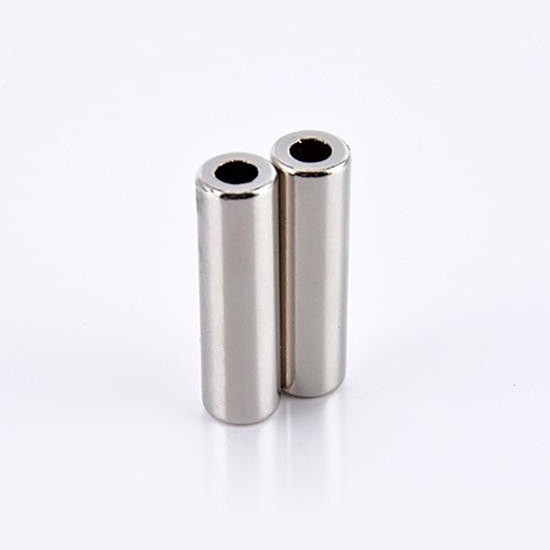What is the maximum pull force of a cylindrical magnet?
 Jul 01, 2025|
Jul 01, 2025| Hey there! As a supplier of Magnet Cylindrical, I often get asked about the maximum pull force of these awesome magnets. So, I thought I'd sit down and write a blog post to answer that question and share some cool insights about cylindrical magnets.
Let's start by understanding what we mean by "pull force." The pull force of a magnet is basically the amount of force it takes to pull the magnet away from a flat, thick steel surface once it's in full contact. It's a crucial factor, especially for those who are using magnets in industrial, scientific, or DIY projects.
Now, the maximum pull force of a cylindrical magnet isn't a one - size - fits - all number. It depends on several factors. First off, the material of the magnet plays a huge role. The most common types of cylindrical magnets are made from neodymium, ferrite, and samarium - cobalt. Neodymium magnets, for example, are known for their super - strong magnetic properties. They can generate a much higher pull force compared to ferrite magnets. If you're looking for high - performance magnets, neodymium Magnet Cylindrical are a top choice.
Another important factor is the size of the magnet. Generally speaking, the larger the magnet, the greater the pull force. A bigger cylindrical magnet has more magnetic material, which means it can create a stronger magnetic field. But it's not just about the overall size. The ratio of the diameter to the height of the cylinder also matters. A magnet with a larger diameter and appropriate height will usually have a higher pull force than a magnet with a smaller diameter, even if their volumes are similar.
The shape of the magnet also affects the pull force. For cylindrical magnets, a smooth and well - finished surface can make a difference. A rough or uneven surface might reduce the contact area with the steel surface, thus decreasing the pull force. Also, magnets with a flat end will have better contact and potentially a higher pull force compared to those with rounded ends.
Let's talk about some practical applications where knowing the maximum pull force is essential. In the manufacturing industry, cylindrical magnets are used in conveyor systems to hold and move metal parts. The pull force needs to be strong enough to keep the parts in place but not so strong that it becomes difficult to remove them when needed. In the world of electronics, Cylindrical Permanent Magnet are used in speakers and motors. The right pull force ensures efficient operation and high - quality sound or performance.
Now, if you're in the market for Hollow Cylinder Magnets, the same principles apply. The pull force of hollow cylinder magnets depends on the material, size, and shape. These magnets are often used in applications where you need to pass a rod or a cable through the center while still having a magnetic effect. For example, in some sensors or in certain types of machinery, hollow cylinder magnets are used to create a magnetic field around a central object.
So, how can you measure the maximum pull force of a cylindrical magnet? Well, there are special tools available, like a pull - force tester. This device measures the force required to separate the magnet from a steel surface. However, it's important to note that the test conditions can affect the results. The surface finish of the steel, the cleanliness of the magnet and the steel, and the alignment of the magnet all play a role.
As a supplier, I've seen many customers come to me with specific requirements for the pull force of their cylindrical magnets. Some need magnets with a very high pull force for heavy - duty applications, while others need magnets with a more moderate pull force for delicate projects. That's why we offer a wide range of cylindrical magnets with different materials, sizes, and pull forces.
If you're thinking about using cylindrical magnets in your project, it's a good idea to do some calculations and tests. You can start by estimating the pull force based on the material and size of the magnet. There are also online calculators available that can give you a rough idea. But remember, these are just estimates, and the actual pull force might vary.


One thing to keep in mind is that the pull force isn't the only thing you should consider when choosing a magnet. You also need to think about the temperature stability of the magnet. Some magnets, like neodymium magnets, can lose their magnetic properties at high temperatures. So, if your project will be exposed to high heat, you might need to choose a magnet with better temperature resistance, like samarium - cobalt magnets.
Another factor is the corrosion resistance. If your magnet will be used in a wet or corrosive environment, you need to make sure it's protected. We offer magnets with different coatings to prevent corrosion and ensure a long - lasting performance.
In conclusion, the maximum pull force of a cylindrical magnet is a complex topic that depends on many factors. But with the right knowledge and the right supplier, you can find the perfect magnet for your needs. Whether you're working on a small DIY project or a large - scale industrial application, we've got the Magnet Cylindrical that can meet your requirements.
If you're interested in learning more about our cylindrical magnets or have any questions about the pull force, feel free to reach out. We're here to help you choose the right magnet and ensure your project is a success. Contact us to start a discussion about your specific needs and let's find the best magnet solution together.
References
- "Magnetism and Magnetic Materials" by David Jiles
- "Handbook of Magnetic Materials" edited by Klaus H. J. Buschow

